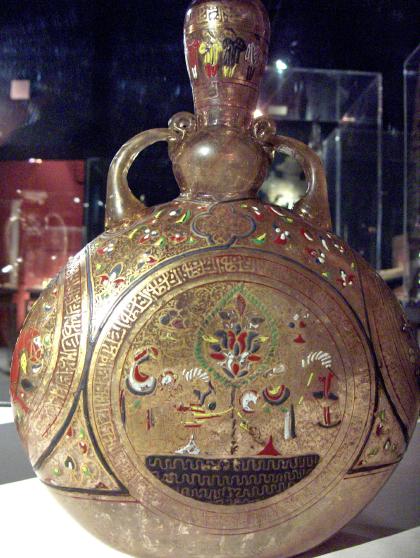Traces of the era of the Turkish wars - such as the tradition of the Vienna coffee house and the Ring boulevard that encircles the city centre - are still evident today in the day-to-day culture and street layout of the Austrian capital. The Turkish sieges of Vienna (16th/17th century) led to an expansion of the city's fortifications and heralded the introduction of coffee.
They also generated a significant increase in the number of works of art from the Islamic world. A study by Prof. Bert Fragner and Dr. Barbara Karl from the Institute of Iranian Studies at the Austrian Academy of Sciences is the first to make an in-depth examination of these objects dating from between the 8th and 19th centuries.

Hidden treasures: The quantity of islamic artefacts in museum collections of Vienna has hitherto obviously been underestimated. A current project of the Austrian Science Fund FWF helps to discover these treasures. Credit: FWF
A few years ago, the number of pieces of art from the Islamic world held in collections in Vienna was still estimated to be around 5,000 but now this number has been found to be around 30,000. One of the reasons why the original estimate proved wide of the mark is the fact that the artifacts are housed in several different collections. For example, various departments of the Kunsthistorisches Museum (Museum of Art History), Heeresgeschichtliches Museum (Museum of Military History), Wien Museum (Vienna Museum) and the Österreichisches Museum für angewandte Kunst (Austrian Museum of Applied Arts) are all home to examples of Islamic art.
The majority of these works have thus far remained out of the public spotlight. In addition, some pieces found their way to Schloss Ambras, which lies 500 km west of Vienna and serves as a branch of the Kunsthistorisches Museum.
SURAS FROM THE KORAN IN ST. STEPHEN'S CATHEDRAL
Looted art, like Ottoman flags that fell into the hands of the imperial army following fierce battles, were paraded in front of the people during military processions or in St. Stephen's Cathedral. Due to their often religious symbols and texts, such as suras from the Koran, flags were a particularly popular means of communicating propaganda. For decades, a red silk flag seized by the imperial army was displayed in St. Stephen¹s Cathedral in Vienna to mark the anniversary of the end of the second Turkish siege.
"Time and time again, the flag was put on show in what represented the religious centre of the Habsburg Empire. The aim was to ensure the memory of the victory over the "enemy of the faith," became deeply ingrained in the minds of the city's population, and to imbue it with a religious, Christian quality," explains Dr. Karl. Today, the flag - also known as the Hamzabeg Flag after the place it was taken from - is housed in the Wien Museum.
IMPERIAL "MARKETING"
A silk flag in the Heeresgeschichtliches Museum represents a further example of the way the Habsburgs made use of captured Ottoman art. The flag was originally displayed in the antechamber of the Treasury in the Vienna Hofburg, the building that embodied the power of the Habsburg Empire. "The way the flag was displayed in the Treasury had the effect of presenting the Emperor as the figure who defended Christianity against the peril of the Islamic/Ottoman enemy," says Dr. Karl. In addition, this was intended to ensure the Habsburg claim to embody the grace of God was firmly embraced by the population as a whole.
The study of the way objects of art from the Islamic world have been used constitutes just one aspect of the project. The pieces are also to be integrated into the overall context of artefacts dating from the Habsburg era, and investigations will be carried out into the significance of the role they have played. In addition, the pieces are to be assigned a place within a chronological, geographical and dynastical structure. In an era where there is an increasing focus on Islam, the project supported by the FWF makes an important contribution to raising awareness of the value and treatment of artifacts originating from other cultures.





Comments